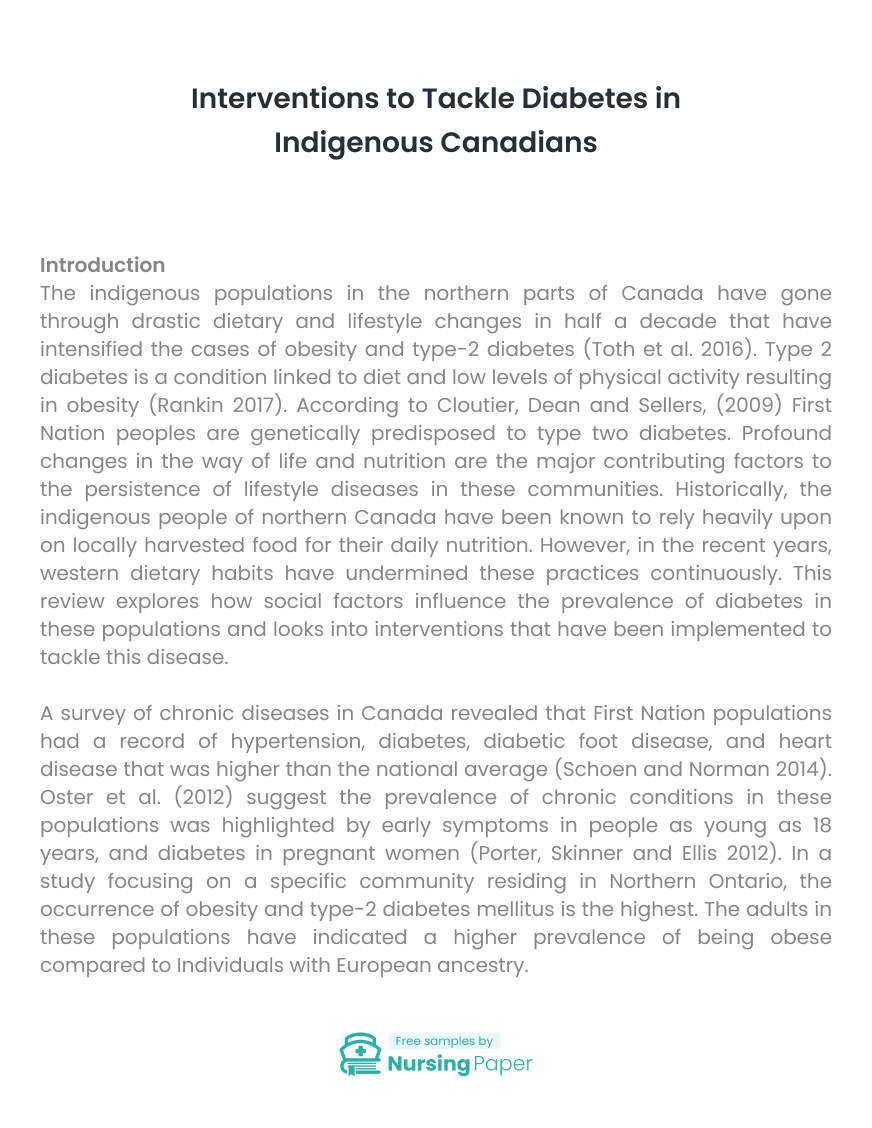1. Carriere, R., Ramsay, J., McGowan, P., Cayer, T., Davies, M. and Hannah, K. (2009). Making it work – addressing program implementation challenges in Indigenous communities. Canadian Journal of Diabetes, 33(3), p.222.
2. Cloutier, J., Dean, H. and Sellers, E. (2009). Type 2 diabetes and growth patterns of offspring of mothers with early-onset type two diabetes in indigenous peoples in Manitoba, Canada: the Next Generation Project. Canadian Journal of Diabetes, 33(3), p.196.
3. Crowshoe, L., Dannenbaum, D., Green, M., Henderson, R., Hayward, M. and Toth, E. (2018). Type 2 Diabetes and Indigenous Peoples. Canadian Journal of Diabetes, 42, pp.S296-S306.
4. Haman, F., Fontaine-Bisson, B., Batal, M., Imbeault, P., Blais, J. and Robidoux, M. (2010). Obesity and type 2 diabetes in Northern Canada’s remote First Nations communities: the dietary dilemma. International Journal of Obesity, 34(S2), pp.S24-S31.
5. Harris, S., Tompkins, J. and TeHiwi, B. (2017). Call to action: A new path for improving diabetes care for Indigenous peoples, a global review. Diabetes Research and Clinical Practice, 123, pp.120-133.
6. Howard, H. (2014). Canadian Residential Schools and Urban Indigenous Knowledge Production about Diabetes. Medical Anthropology, 33(6), pp.529-545.
7. Institute of Health Economics (2017). Diabetes care and management in Indigenous populations in Canada. Alberta, Canada: Institute of Health Economics.
8. Isaak, C. and Marchessault, G. (2008). Meaning of Health: The Perspectives of Aboriginal Adults and Youth in a Northern Manitoba First Nations Community. Canadian Journal of Diabetes, 32(2), pp.114-122.
9. Jacklin, K.M., PhD., Henderson, R.I., PhD., Green, Michael E,M.D., M.P.H., Walker, L.M., Calam, Betty, MD,M.ClSc, B.A. & Crowshoe, L.J., M.D. 2017, “Health care experiences of Indigenous people living with type 2 diabetes in Canada”, Canadian Medical Association.Journal, vol. 189, no. 3, pp. E106-E112.
10. Kolahdooz, F., Nader, F., Yi, K. and Sharma, S. (2015). Understanding the social determinants of health among Indigenous Canadians: priorities for health promotion policies and actions. Global Health Action, 8(1), p.27968.
11. Leung, L. (2016). Diabetes mellitus and the Aboriginal diabetic initiative in Canada: An update review. Journal of Family Medicine and Primary Care, 5(2), p.259.
12. McGavock, J., Dart, A., Sellers, E., Durksen, A. and Wicklow, B. (2016). Readiness for Change Among Indigenous Youth with Type 2 Diabetes. Canadian Journal of Diabetes, 40(5), p.S23.
13. Naqshbandi, M., Harris, S., Esler, J. and Antwi-Nsiah, F. (2008). Global complication rates of type 2 diabetes in Indigenous peoples: A comprehensive review. Diabetes Research and Clinical Practice, 82(1), pp.1-17.
14. Neufeld, H. (2011). Food Perceptions and Concerns of Aboriginal Women Coping with Gestational Diabetes in Winnipeg, Manitoba. Journal of Nutrition Education and Behavior, 43(6), pp.482-491.
15. Oster, R., Johnson, J., Balko, S., Svenson, L. and Toth, E. (2012). Increasing rates of diabetes amongst status Aboriginal youth in Alberta, Canada. International Journal of Circumpolar Health, 71(1), p.18501.
16. Pan American Health Organization (2011). POPULATION AND INDIVIDUAL APPROACHES TO THE PREVENTION AND MANAGEMENT OF DIABETES AND OBESITY. World Health Organization.
17. Porter, C., Skinner, T. and Ellis, I. (2012). The current state of Indigenous and Aboriginal women with diabetes in pregnancy: A systematic review. Diabetes Research and Clinical Practice, 98(2), pp.209-225.

The download will start shortly.






 Subject:
Subject:
 Number of pages: 6
Number of pages: 6